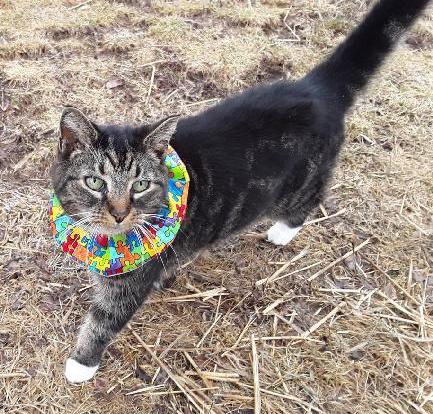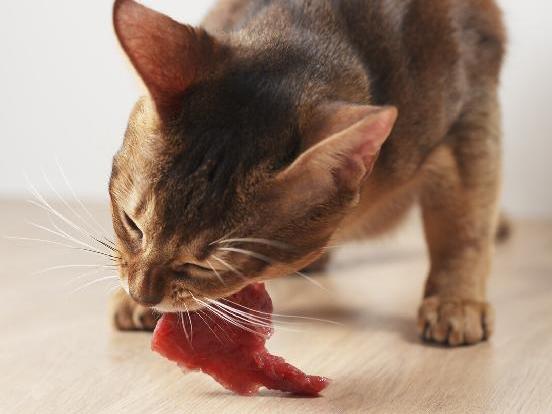
10 minute read
walk on a loose leash
f e l i n e Playing It Safe
Andrea Carne reports on a new study that reveals how playtime and a meatier diet can reduce hunting behavior in cats
Advertisement
A study by Cecchetti et al. (2021) found that cats who engaged in play with their guardians using a wand toy for just 5 to 10 minutes a day brought home 25% fewer prey animals
© Can Stock Photo / adogslifephoto
“Play with your cat more – and give him a meaty diet…” I wouldn’t be surprised if variations on this kind of advice has been given by vets and cat behavior consultants over the eons. And indeed, in addition to being supportive of feline wellbeing in general, a new study suggests it could also reduce hunting behavior and, perhaps more importantly for many cat guardians, reduce the number of prey animals brought home as unwanted “gifts.”
The study, conducted by Martina Cecchetti and colleagues from the University of Exeter in the U.K. and published earlier this year, looked at various types of “interventions” aimed at reducing feline hunting, rather than impeding it, and whether these interventions had an effect on the amount of prey brought home.
As the study explains: “Predation by domestic cats Felis catus can be a threat to biodiversity conservation, but its mitigation is controversial. Confinement and collarmounted devices can impede cat hunting success and reduce numbers of animals killed, but some owners do not wish to inhibit what they see as natural behavior…” (Cecchetti et al., 2021).
So, instead of interventions which work on impeding hunting behavior – including complete confinement indoors, for instance – the study looked at what it calls “noninvasive” interventions which aim to reduce a cat’s want or tendency to hunt and/or their success in doing so, and whether these can actually be effective.
Research
The research team focused on 219 homes in southwest England in which 355 cats resided. The guardians chosen were those whose cats regularly hunted and captured wild animals and brought them back home. Of the feline participants, 30 were given a bell to wear on their collars and 33 were given a specific Birdsbesafe branded soft collar (see box on opposite page) to wear (both aimed at scaring off prey). A further 41 cats were given a puzzle toy for food dispensing, 40 were given a meatier diet (commercial, grainfree food with meat as the primary source of protein) and 38 were played with on a daily basis. There was also a control group in which nothing was changed whatsoever.
Over a period of 12 weeks, the cats were studied via guardians reporting on the number of prey animals brought home each day by each cat, and compared that with numbers of same logged by guardians over a sevenweek period prior to the introduction of the interventions.
The study ultimately found that cats who engaged in play with their guardians using a wand toy for just 5 to 10 minutes a day brought home 25% fewer prey animals. In addition, it found that cats fed more meatbased protein in their meals brought home 36% less prey.
It’s worth noting here that cats do not bring home all the prey that they kill. However, it’s reasonable to assume cats are generally consistent with the percentage they bring home, making the study still relevant in comparing numbers.
Results
The results were interesting on a number of levels. Strange as it may seem, the cats given puzzle toys actually hunted more. And while the Birdsbesafe collars were effective in reducing the numbers of birds brought home (by 42%), they had no effect on the number of mammals caught. However, while there were varying degrees of success with all items, the meatier diet and playtime came out on top as being the most
effective strategies in reducing the amount of prey brought home.
The researchers surmised this would be welcome news to many cat guardians: "Reductions in predation can be made by noninvasive, positive contributions to cat nutrition and behavior that reduce their tendency to hunt, rather than impede their hunting…These measures are likely to find support among cat owners who are concerned about the welfare implications of other interventions." (Cecchetti, et al., 2021).
Now, there are some issues with this study, which the researchers themselves acknowledge and which point to further study being necessary. This includes the cats potentially not having enough time to become familiar with the food puzzles and their resulting frustration possibly leading to more of a tendency to hunt. There were also some issues with palatability of the meatier diet provided, particularly the wet version, which may have affected outcomes.
But despite some possible shortcomings, what I personally applaud this study for is providing more evidence that supports the importance of play for cats.
Play
As a cat behavior consultant, I am always encouraging guardians to play with their cats more. Not only is it good for the cats’ overall health and wellbeing; it can also help with behavior modification programs and build the bond between cat and guardian. Now, I can happily say it has the added benefit of reducing the hunting of live prey and bringing some of those kills home – which is a common cause of distress for cat guardians who allow their cats access to the outdoors.
In the Cecchetti study (2021), a wand toy was provided as the tool of choice for object play. The research team found that the majority of cats in the object play group immediately responded to the toy and that many of the guardians intended to continue the activity following the study.
This is good news – for all cat guardians, including those with indooronly felines. What we must understand is that, just because our cats may not have access to hunting live prey by being kept indoors, they do not lose the natural instinct to hunt. It is therefore a vital part of cat ownership and advocacy that guardians provide outlets for this natural behavior (particularly if their cats are indooronly) and object play can provide just that, if it’s done in a behaviorallyappropriate way.
Wand toys are particularly good for providing a sequence through which cats can display innate hunting behavior without actually killing anything. By mimicking a bird or other animal in flight or motion, using a wand toy allows cats the opportunity to stalk the “prey,” to pounce on it – sometimes getting it, sometimes not – manipulate it (which often involves flopping on their backs to play with it), and then, if guardians finish the sequence by throwing a tasty treat, the cat can “devour” something. Such sequences are important for the cat to display all elements of hunting behavior and to avoid the frustration that may come if they are never able to actually catch the “prey.”
A series of short, energetic bouts of play with a rest in between, is also recommended, rather than a lengthy bout which can lead to overstimulation.
Food Puzzles
And, despite food puzzles being problematic in the U.K. study in terms of reducing hunting behavior, they remain one of my favorite energy busters – where cats have to use their brains to solve puzzles in order to get food. But they can also act as object play when used in a way that involves the hunting behaviors of foraging, pouncing, manipulating and devouring.
There is a multitude of options available online or in pet stores, including Kongs™, but guardians can also make their own. Ideas include: • Cardboard toilet roll or paper towel centers with a treat inside and the ends squashed down. • Small boxes such as tissue boxes (with any plastic removed) and treats inside. • An empty plastic water bottle with some holes cut in and treats inside – that needs to be rolled around for the treats to fall out.
Research Shows Brightly Colored Collar Can Reduce Number of Birds Caught by Cats
© Birdsbesafe LLC As songbirds see bright colors, an accessory of bright colors around a cat’s neck could help make the cat easier for the birds to see—and avoid The patented Birdsbesafe® cat collar cover was invented in Vermont, U.S., to solve the problem of the inventor's cat hunting and harming birds. The inventor was aware that songbirds see bright colors especially well, due to their eye anatomy, and so she reasoned that putting an accessory of bright colors around a cat’s neck could help make the cat easier for the birds to see—and fly away from. When the colorful collar accessory worked to stop the cat’s bird captures, the inventor set a goal of popularizing the product through her company, Birdsbesafe LLC.
More than 10 years after the invention, the product has been validated in more than five scientific field studies globally. The U.K. has had two studies, of which the Cecchetti study is the most recent. A previous study from Scotland found a 78% reduction in birds caught, and in the U.S., an average of 87% reduction in birds caught was shown.
Rodents that cats may prey upon are not much protected by the Birdsbesafe collar cover because they do not have particularly good color vision. Songbirds can even see bright colors well in low light conditions, because of their eye anatomy.

Nancy Brennan, owner/founder Birdsbesafe LLC
© Can Stock Photo / GoooDween123 Cecchetti et al.’s study (2021) found that feeding cats a meatier diet was one of the most effective strategies in reducing the amount of prey they brought home

• An egg carton with the lid down and treats inside. • A mini muffin baking tray with treats in each hole and ping pong balls on top. • A sensory box – a larger cardboard box filled with scrunched up paper, leaves, bits of bark etc. – and some treats thrown in that they have to forage for. • A treasure hunt placed around the whole house with treats wrapped up in a bit of paper.
All of these involve not only mental stimulation but also call on behaviors involved with hunting for food which, together with play sessions with wand toys, can provide great enrichment for cats of all ages.
Enrichment for our feline family members comes in many forms, but play (with toys and via food puzzles) is so very important. I, for one, am very appreciative of studies such as that by Cecchetti and colleagues, which offer evidence of the benefits of play not only to cats and their guardians but also to wildlife populations.
Let’s hope researchers look further into this interesting field to provide more evidence supporting the importance of play for cats in order for them to lead happy, healthy, behaviorallyenriched lives. n
Reference
Cecchetti, M., Crowley, S.L., Goodwin, C.E.D., & McDonald, R.A. (2021). Provision of High Meat Content Food and Object Play Reduce Predation of Wild Animals by Domestic Cats Felis catus. Current Biology. DOI: 10.10.16/j.cub.2020.12.044
Resources
Birdsbesafe® Birdsbesafe® [Video File] Pemberton, C., & Ruxton, G.D. (2019). Birdsbesafe® collar cover reduces bird predation by domestic cats (Felis catus). Journal of Zoology (310) 2 106-109 Pineda, J, (2016). Veterinarian is Out to Change How We Feed Cats. Veterinary Practice News
Andrea Carne is a graduate of the University of Southern Queensland, Australia where she majored in journalism and drama before, later in life, following her dream to work in the field of animal behavior. She is a qualified veterinary nurse and dog trainer and member of PPG Australia. Her special area of interest is cat behavior and her passion for it led to the establishment of her own cat behavior consultancy Cattitude, based in southern Tasmania, through which she offers private in-home consultations.












